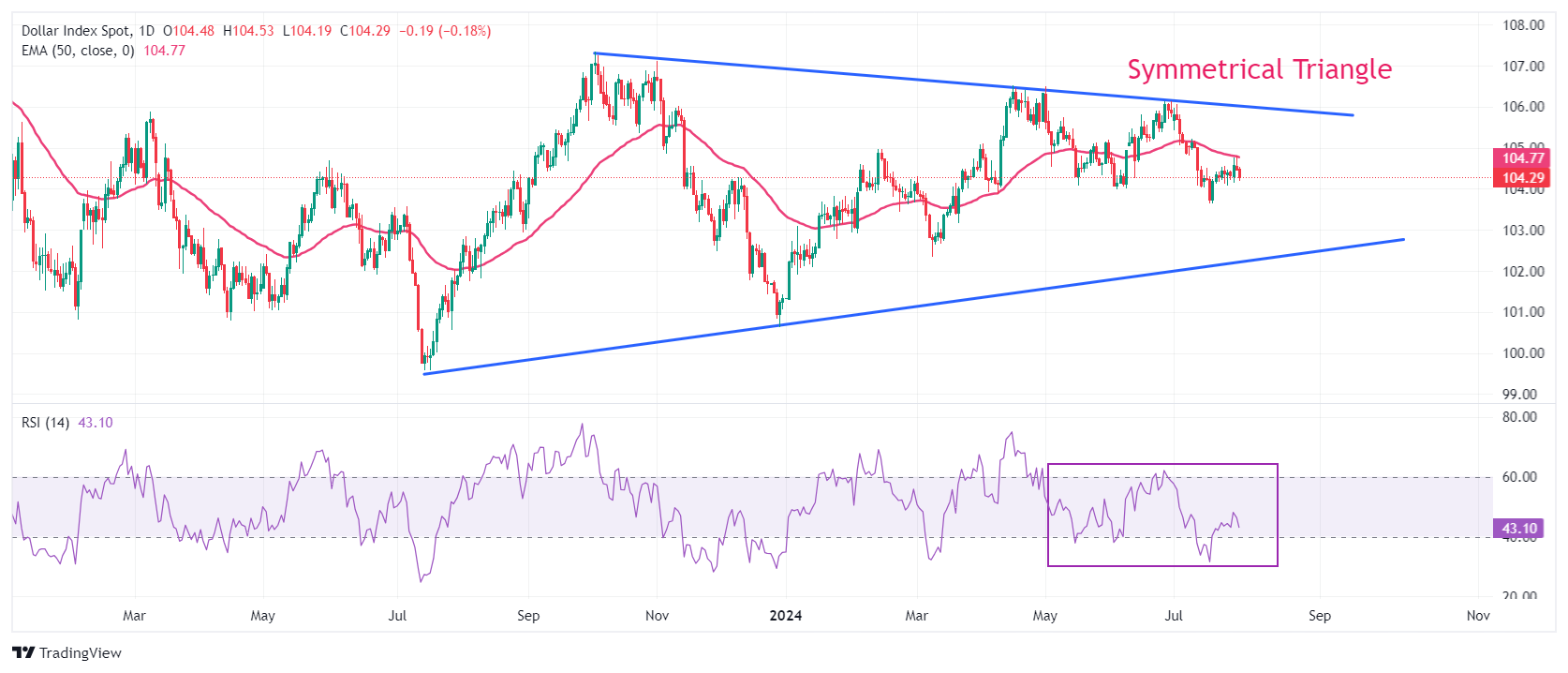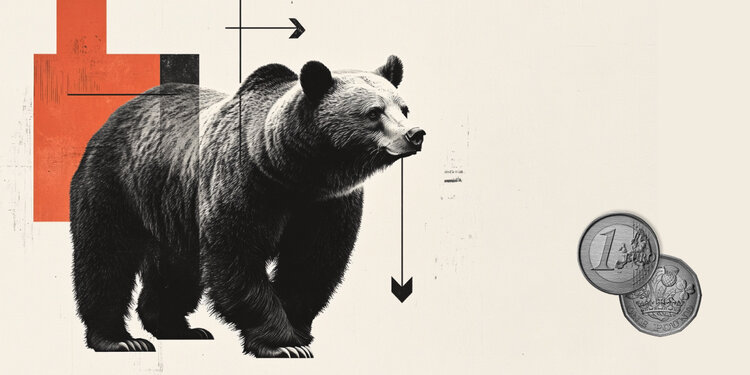- The US dollar falls slightly on expectations that the Fed will offer dovish guidance.
- Investors see the Fed acknowledging progress in inflation and growing risks to labor market strength.
- After Fed policy, the US NFP report for July will be the key trigger for the US Dollar.
The US Dollar (USD) is performing subdued in the European session on Wednesday ahead of the Federal Reserve (Fed) monetary policy announcement at 18:00 GMT. The Dollar Index (DXY), which tracks the value of the Greenback against six major currencies, is down near 104.40. The 10-year US Treasury bond yields are flat near a more than four-month low around 4.14% on expectations that the Fed policy outcome will not be favorable for the consistency of the restrictive interest rate framework.
Investors see the Fed leaving interest rates unchanged in the 5.25%-5.50% range for the eighth consecutive meeting. However, communication on interest rate guidance is expected to be dovish due to easing inflationary pressures in the United States (US) and moderating labor market strength.
Unicredit Research said in a note: “The Fed will likely leave rates unchanged but will send a clear signal that it is moving closer to cutting rates and could do so as early as September.”
Daily Market Wrap: US Dollar Underperforms Ahead of Fed Policy
- The US Dollar underperforms its major peers, except the Australian Dollar (AUD), on Wednesday. The Dollar weakens on expectations that the Fed will turn dovish this time. Investors await Fed Chair Jerome Powell’s monetary policy statement and conference to find out how soon and by how much the central bank will cut interest rates this year. The Aussie weakens on the back of the expected drop in the second quarter annual Consumer Price Index (CPI) print.
- According to the CME FedWatch tool, 30-day federal funds futures price data show the central bank will cut interest rates by 25 basis points (bps) from their current levels at the September meeting. The data also show there will be two rate cuts instead of one, as policymakers projected in the Fed’s latest dot plot.
- Expectations for a dovish Fed stance have been driven by persistent downside risks to inflation and moderating labor market strength. The U.S. CPI slowed more than expected in May and June, suggesting that the disinflation process has resumed, having reversed in the first quarter of the year. Meanwhile, moderating labor demand and an unemployment rate at its highest level in more than two years have indicated that the labor market is no longer resilient.
- Ahead of the Fed decision, the US ADP employment change for July will be in focus. The report is estimated to show that private payrolls rose steadily by 150K.
- Volatility in the FX domain is set to last throughout the week as the US ISM Manufacturing Purchasing Managers’ Index (PMI) and Non-Farm Payrolls (NFP) for July are scheduled for release, due on Thursday and Friday respectively.
- Meanwhile, market sentiment remains firm despite growing fears of an expanding conflict in the Middle East. The killing of Hamas leader Ismail Haniyeh in an Israeli airstrike in Tehran has raised risks of a possible escalation in the war between Israel and Iran. Historically, geopolitical tensions make investors risk-averse, but investors have already priced in Middle East concerns.
US Dollar Price Today:
US Dollar PRICE Today
The table below shows the percentage change of the US Dollar (USD) against major currencies today. The US Dollar was the strongest currency against the Australian Dollar.
| USD | EUR | GBP | JPY | CAD | AUD | NZD | CHF | |
|---|---|---|---|---|---|---|---|---|
| USD | -0.01% | 0.07% | -1.56% | -0.03% | 0.74% | -0.16% | -0.13% | |
| EUR | 0.01% | 0.10% | -1.48% | -0.02% | 0.74% | -0.13% | -0.12% | |
| GBP | -0.07% | -0.10% | -1.60% | -0.12% | 0.63% | -0.23% | -0.20% | |
| JPY | 1.56% | 1.48% | 1.60% | 1.58% | 2.29% | 1.38% | 1.46% | |
| CAD | 0.03% | 0.02% | 0.12% | -1.58% | 0.74% | -0.14% | -0.10% | |
| AUD | -0.74% | -0.74% | -0.63% | -2.29% | -0.74% | -0.87% | -0.85% | |
| NZD | 0.16% | 0.13% | 0.23% | -1.38% | 0.14% | 0.87% | 0.03% | |
| CHF | 0.13% | 0.12% | 0.20% | -1.46% | 0.10% | 0.85% | -0.03% |
The heatmap shows percentage changes of major currencies. The base currency is selected from the left column, while the quote currency is selected from the top row. For example, if you choose the US Dollar from the left column and move along the horizontal line to the Japanese Yen, the percentage change shown in the chart will represent the USD (base)/JPY (quote).
Technical Analysis: US Dollar faces resistance near 50-day EMA
The Dollar Index is trading in a Symmetrical Triangle formation on a daily time frame, which exhibits a sharp contraction in volatility. The mentioned chart pattern results in a sideways trend with lower volume and smaller ticks. The short-term trend remains bearish as the 50-day Exponential Moving Average (EMA) around 104.77 acts as a major barrier for the US Dollar bulls.
The 14-day Relative Strength Index (RSI) is fluctuating in the range of 20.00-60.00, suggesting that the overall trend is bearish. While the bearish momentum is dormant.
On the upside, the July 9 high at 105.20 and the three-month high near 106.00 will be key resistances for the US Dollar. While the July 17 low at 103.65 and the March 8 low at 102.35 will be key support areas.
US Dollar FAQs
The United States Dollar (USD) is the official currency of the United States of America, and the de facto currency of a significant number of other countries where it is in circulation alongside local banknotes. As of 2022, it is the most traded currency in the world, accounting for over 88% of all global foreign exchange transactions, equivalent to an average of $6.6 trillion in daily transactions. Following World War II, the USD took over from the British Pound as the world’s reserve currency.
The single most important factor influencing the value of the US dollar is monetary policy, which is determined by the Federal Reserve (Fed). The Fed has two mandates: to achieve price stability (control inflation) and to promote full employment. Its main tool for achieving these two goals is to adjust interest rates. When prices rise too quickly and inflation exceeds the Fed’s 2% target, the Fed raises rates, which helps the dollar. When inflation falls below 2% or the unemployment rate is too high, the Fed can lower interest rates, which weighs on the dollar.
In extreme situations, the Federal Reserve can also print more dollars and enact quantitative easing (QE). QE is the process by which the Fed substantially increases the flow of credit in a jammed financial system. It is an unconventional policy measure used when credit has dried up because banks are not lending to each other (for fear of counterparty default). It is a last resort when simply lowering interest rates is unlikely to achieve the necessary result. It was the Fed’s weapon of choice to combat the credit crunch that occurred during the Great Financial Crisis of 2008. It involves the Fed printing more dollars and using them to buy US government bonds, primarily from financial institutions. QE typically leads to a weakening of the US dollar.
Quantitative tightening (QT) is the reverse process whereby the Federal Reserve stops buying bonds from financial institutions and does not reinvest the principal of maturing securities in new purchases. It is generally positive for the US dollar.
Source: Fx Street
I am Joshua Winder, a senior-level journalist and editor at World Stock Market. I specialize in covering news related to the stock market and economic trends. With more than 8 years of experience in this field, I have become an expert in financial reporting.








